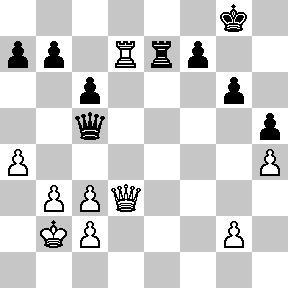Topalov beats Bacrot ... or does Bacrot just blow it.
Topalov,V (2801) - Bacrot,E (2717) [C42]
Corus A Wijk aan Zee NED (3), 16.01.2006
1.e4 e5 2.Nf3 Nf6 3.Nxe5 d6 4.Nf3 Nxe4 5.Nc3 Nxc3 6.dxc3 Be7 7.Bf4 0-0 8.Qd2 Nd7 9.0-0-0 Nc5 10.h4 Bf6 11.Ng5 h6 12.Bd3 Nxd3+ 13.Qxd3 g6 14.Nf3 h5 15.Rde1 Bf5 16.Qd2 Re8 17.Bg5 Bxg5 18.Nxg5 Qf6 19.f3 Re5 20.Rxe5 dxe5 21.Rd1 Qc6 22.b3 Re8 23.Kb2 e4 24.fxe4 Bxe4 25.Qf4 Bf5 26.Rd2 Qc5 27.Nf3 Bg4 28.a4 Bxf3 29.Qxf3 c6 30.Rd7 Re7 31.Qd3 Rxd7 32.Qxd7 Qb6 33.b4 c5 34.a5 Qc6 35.Qxc6 bxc6 36.Kb3 Kf8 37.Kc4 Ke7 38.Kxc5 Kd7 39.c4 f6 40.b5 g5 41.b6 axb6+ 42.Kxb6 Kc8 43.Kxc6 gxh4 44.c5 1-0
Reading over this game this afternoon I was... well I was very confused. Bacrot unleashed the mighty Petrov (haha) against Topalov, evidently seeking a draw. Topalov responded with the eccentric 5. Nc3 variation, seeking a quick doubling of his own pawns in return for dynamic and obscure play. It didn't seem to be working out for him by 22. ... Re8, however. Bacrot has managed his pieces alright and Topalov doesn't seem to have much to atone for the doubles. Maybe the game will draw from here, I thought, and maybe Topalov will even lose. True enough, he has better control of the dark squares, and Bacrot has some airy squares around his king, but... well anyway. Bacrot seemed to go wrong somewhere in the maneuvering stage, when neither player had much left on the board. I think the following position, before the exchange of rooks was an important decisive stage, but I still don't really get it.
Bacrot has managed his pieces alright and Topalov doesn't seem to have much to atone for the doubles. Maybe the game will draw from here, I thought, and maybe Topalov will even lose. True enough, he has better control of the dark squares, and Bacrot has some airy squares around his king, but... well anyway. Bacrot seemed to go wrong somewhere in the maneuvering stage, when neither player had much left on the board. I think the following position, before the exchange of rooks was an important decisive stage, but I still don't really get it. It seems that Bacrot should really be doing alright after something like ...b6. Ah well, I will have to Fritz it and see. What really struck me was that Bacrot kept playing after the exchange of queens, long after it was clear as day that he was dead lost.
It seems that Bacrot should really be doing alright after something like ...b6. Ah well, I will have to Fritz it and see. What really struck me was that Bacrot kept playing after the exchange of queens, long after it was clear as day that he was dead lost.
Corus A Wijk aan Zee NED (3), 16.01.2006
1.e4 e5 2.Nf3 Nf6 3.Nxe5 d6 4.Nf3 Nxe4 5.Nc3 Nxc3 6.dxc3 Be7 7.Bf4 0-0 8.Qd2 Nd7 9.0-0-0 Nc5 10.h4 Bf6 11.Ng5 h6 12.Bd3 Nxd3+ 13.Qxd3 g6 14.Nf3 h5 15.Rde1 Bf5 16.Qd2 Re8 17.Bg5 Bxg5 18.Nxg5 Qf6 19.f3 Re5 20.Rxe5 dxe5 21.Rd1 Qc6 22.b3 Re8 23.Kb2 e4 24.fxe4 Bxe4 25.Qf4 Bf5 26.Rd2 Qc5 27.Nf3 Bg4 28.a4 Bxf3 29.Qxf3 c6 30.Rd7 Re7 31.Qd3 Rxd7 32.Qxd7 Qb6 33.b4 c5 34.a5 Qc6 35.Qxc6 bxc6 36.Kb3 Kf8 37.Kc4 Ke7 38.Kxc5 Kd7 39.c4 f6 40.b5 g5 41.b6 axb6+ 42.Kxb6 Kc8 43.Kxc6 gxh4 44.c5 1-0
Reading over this game this afternoon I was... well I was very confused. Bacrot unleashed the mighty Petrov (haha) against Topalov, evidently seeking a draw. Topalov responded with the eccentric 5. Nc3 variation, seeking a quick doubling of his own pawns in return for dynamic and obscure play. It didn't seem to be working out for him by 22. ... Re8, however.
 Bacrot has managed his pieces alright and Topalov doesn't seem to have much to atone for the doubles. Maybe the game will draw from here, I thought, and maybe Topalov will even lose. True enough, he has better control of the dark squares, and Bacrot has some airy squares around his king, but... well anyway. Bacrot seemed to go wrong somewhere in the maneuvering stage, when neither player had much left on the board. I think the following position, before the exchange of rooks was an important decisive stage, but I still don't really get it.
Bacrot has managed his pieces alright and Topalov doesn't seem to have much to atone for the doubles. Maybe the game will draw from here, I thought, and maybe Topalov will even lose. True enough, he has better control of the dark squares, and Bacrot has some airy squares around his king, but... well anyway. Bacrot seemed to go wrong somewhere in the maneuvering stage, when neither player had much left on the board. I think the following position, before the exchange of rooks was an important decisive stage, but I still don't really get it. It seems that Bacrot should really be doing alright after something like ...b6. Ah well, I will have to Fritz it and see. What really struck me was that Bacrot kept playing after the exchange of queens, long after it was clear as day that he was dead lost.
It seems that Bacrot should really be doing alright after something like ...b6. Ah well, I will have to Fritz it and see. What really struck me was that Bacrot kept playing after the exchange of queens, long after it was clear as day that he was dead lost.

1 Comments:
for 5 Nc3, see IM kaufman's book Chess advantage in black and white - this is actually sharp attacking try to avoid the drawish (at highest levels) Petroff {at lower levels, Petroff can actually be sharp, especially, if black is willing to sac a pawn or a piece for a kingside attack
Post a Comment
<< Home